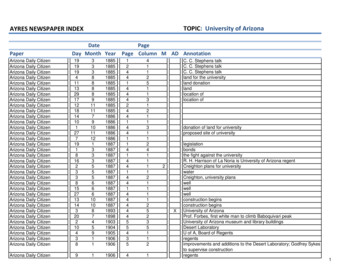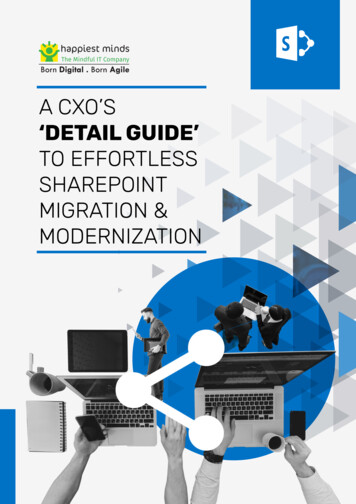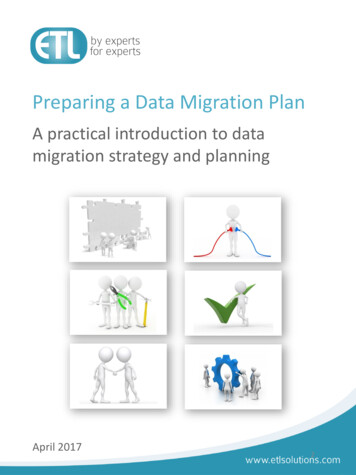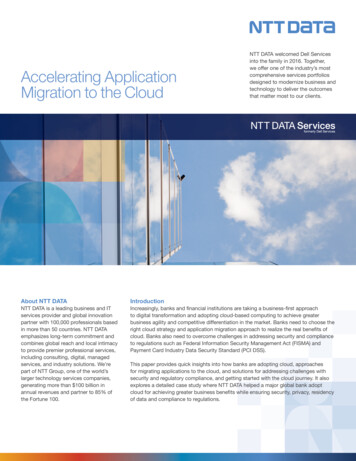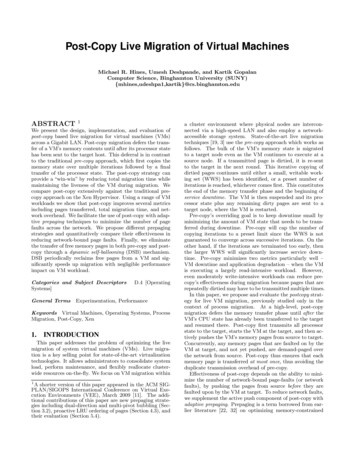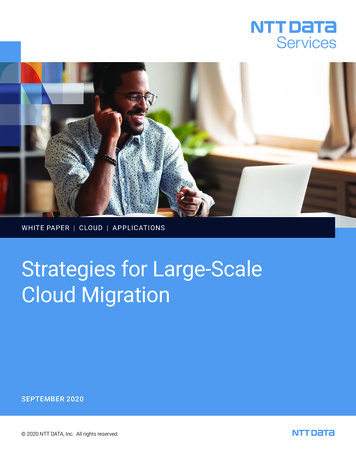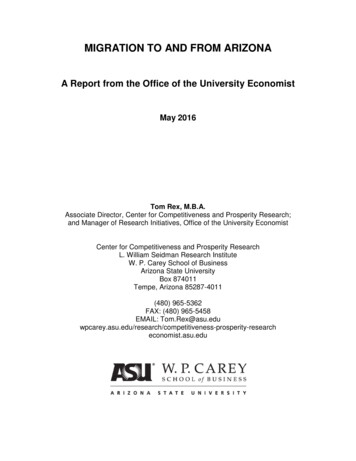
Transcription
MIGRATION TO AND FROM ARIZONAA Report from the Office of the University EconomistMay 2016Tom Rex, M.B.A.Associate Director, Center for Competitiveness and Prosperity Research;and Manager of Research Initiatives, Office of the University EconomistCenter for Competitiveness and Prosperity ResearchL. William Seidman Research InstituteW. P. Carey School of BusinessArizona State UniversityBox 874011Tempe, Arizona 85287-4011(480) 965-5362FAX: (480) 965-5458EMAIL: eness-prosperity-researcheconomist.asu.edu
TABLE OF CONTENTSSummaryData Sources and DefinitionsNet Migration Estimates From the University of WisconsinMigration and Income Data From the Internal Revenue ServiceMigration Estimates From the American Community SurveyComparison of Migration Estimates1410193446LIST OF TABLES1. Migration Between Arizona and Selected States, Cumulative Total From 2001 Through20142. Migration by Arizona County, 20143. Migration Efficiency in the Phoenix and Tucson Metropolitan Areas With SelectedMetropolitan Areas, 20144. Number of Personal Exemptions by Age of Primary Taxpayer, 20145. Average Adjusted Gross Income, Western States, 20146. Average Adjusted Gross Income by Age of Primary Taxpayer, 20147. Educational Attainment Ranks, Arizona, 2010-148. Median Individual Income in Western States, 2010-149. Comparison of Domestic Migration Figures, Arizona232627283031424547LIST OF CHARTS1. Net Migration by Decade, United States2. Net Migration Rate by Age Group by Decade, United States3. Net Migration by Decade, Arizona4. Net Migration Rate by Age Group by Decade, Arizona5. Net Migration Rate by Decade In Selected States6. Net Migration Rate by Age Group, 2000 To 2010, High-Ranking States on Overall Rate andOverall Number7. Net Migration Rate by Arizona County, 2000 To 20108. Number of Domestic Migrants, Arizona9. Net Number of Domestic Migrants, Arizona10. Number of Domestic Migrants Per 1 Million U.S. Residents, Arizona11. Migration To and From Arizona12. Age Distribution of Population 1 and Older, Arizona Less the National Average, 2010-1413. Educational Attainment of the Population 25 and Older, Arizona Less the National Average,2010-1414. Median Individual Income of Those Earning Income by Mobility Category, 2010-1415. Domestic Migration Efficiency, Arizona16. Total Net Migration, Arizonai10111213141617192021343841434849
SUMMARYThe migration of individuals to and from Arizona is of particular significance since so much ofthe state’s population growth results from migration. Net migration, from other states and fromother countries, accounted for more than 62 percent of Arizona’s total population change in eachof the last four decades. The share of population change resulting from net migration in Arizonahas consistently been one of the highest among the states.Generally, Arizona’s migration patterns have not changed significantly in recent decades. Theage distribution of Arizona’s migrants differs from the national average. Nationally, migrationrates are highest among young adults and lower with age. Arizona’s migrants disproportionatelyconsist of older adults, especially those who move after they retire. A comparison of the state’sin-migrants and out-migrants shows that on net, Arizona’s population growth disproportionatelyconsists of older adults, with younger adults, especially very young adults, underrepresented.A comparison of income by age group reveals that among younger adults, in-migrants to Arizonahave lower incomes than out-migrants from Arizona. The situation is reversed among olderadults, with in-migrants to the state having much higher incomes than out-migrants. Compared tothe national average, the incomes of the state’s in-migrants are below average except amongthose 65 and older.The educational attainment of Arizona’s migrants is somewhat below the national average, butrecent data on the educational attainment of migrants by age group are not available. Combiningthe recent data on the overall educational attainment of migrants with older data on theeducational attainment of migrants by age and recent data on the income of migrants by agesuggests that the state’s educational attainment benefits from the migration of older adults butsuffers from the migration of younger adults. However, few of the migrating older adults areactive in the Arizona workforce.For most individuals other than retirees, migration is dependent upon obtaining a job. Thus, netmigration to Arizona is highly correlated to the economic cycle.Net migration to Arizona — particularly resulting from immigration from other countries — wasunusually strong from the early 1990s through mid-2000s, but has been below the historicalnorm since then. Apart from this and fluctuations tied to the economic cycle, the net number ofmigrants to Arizona has been steady over the last several decades despite large increases in thestate’s population. Thus, relative to the state’s population, migration rates have fallensubstantially. Relative to the national population, in-migration rates have dropped while outmigration rates have held steady.Numerically, the state with the greatest flow of migrants to and from Arizona is California.However, Arizona’s migration rates are highest with Rocky Mountain states.Three datasets are examined in this paper, each of which provides migration data by state andcounty. Each data source has advantages and limitations: University of Wisconsin. This dataset provides the most complete and accurate migrationdata since it is based on decennial census counts and the number of births and deaths. It1
also provides data by the age of the migrant. However, only net migration is available,the data are available only by decade, and no distinction can be made between domesticmigration and international migration.Internal Revenue Service. Reasonably accurate annual data are available on domestic inand out-migration, but only for the subset of the population that files a tax return in agiven year. Immigrants are not included. Some information is available by age andincome.American Community Survey. Annual data are available on domestic in- and outmigration as well as immigration, and a broad range of characteristics, such aseducational attainment, are available for migrants. However, since the number of peoplemigrating in any year is small, survey error is very large. Even after aggregating fiveyears of data, survey error remains significant.University of WisconsinNationally, net migration consists entirely of net international migration: immigration,emigration, and the movement of U.S. citizens to and from other countries. Numeric netmigration to the United States rose in the 1980s and 1990s before dropping back in the 2000s,though the net number during the 2000s still was historically high. The net migration rate — thenumber of migrants relative to the number of residents — also slipped in the 2000s but remainedhistorically high.By state, net migration consists of net international migration and net domestic migration(migration to and from other U.S. states). Net migration to Arizona rose considerably during the1990s but was lower during the 2000s. Metropolitan Phoenix has dominated the state’s netmigration, accounting for more than 70 percent in five of the last six decades.Nationally, net migration rates are highest among young adults. In Arizona, a peak occurs amongyoung adults, but even higher rates are present at retirement age. Arizona’s population growthhas disproportionately consisted of the net in-migration of people when they retire.Internal Revenue ServiceAnnual domestic in- and out-migration data from the IRS going back to 1981 show that Arizonaexperiences considerable cyclicality in its migration flows, with in-migration dropping but outmigration rising during economic recessions, with the reverse occurring during economicexpansions. Thus, annual net migration is very cyclical.Despite the state’s rapid growth in population, little trend is present in its numbers of in- and outmigrants. Thus, migration rates have fallen considerably as calculated by the state’s population.Relative to the national population, the in-migration rate has declined while the out-migrationrate has held steady.California has been the dominant source and destination of Arizona’s domestic migrants, thoughthe highest in- and out-migration migration rates, as calculated by the population of the otherstate, are with other Rocky Mountain states. Net migration has been greatest from California,followed by Illinois, Michigan, and New York. The net migration rate generally has been highestwith other western states, including California, but Illinois also is on the list.2
Migration by age data, categorized by the age of the primary tax filer, are provided by the IRS.Relative to migrants nationally, Arizona has a higher proportion of in-migrants age 55 and older,with a lesser share younger than 35. The out-migrant proportion is above average for those 65and older and below average for those 26-to-44 years old.The IRS also provides income data for migrants, but it is not known what portion of the annualincome was earned at the prior address versus the new address. Nationally, migrants haveconsiderably lower incomes than nonmigrants due to the disproportionate share of migrants whoare young adults. Though the average income of nonmigrants in Arizona is considerably lessthan the national average, and the average income of out-migrants also is below average, theaverage income of in-migrants is nearly equal to the U.S. average, reflecting the disproportionateshare of Arizona’s in-migrants who are older adults.In terms of income, Arizona benefits from the migration of older adults — but few of thesemigrants are active in the workforce. In contrast, the migration of the working-age populationwas to the state’s detriment in recent years, with those moving in having lower incomes thanthose leaving. Among younger adults, Arizona’s ratio of the average income of in-migrants tothe average income of out-migrants ranked 40th among the states.American Community SurveyThe ACS provides more detail on the age of migrants than does the IRS, including all migrantsand more narrow age groupings. Nationally, migrants disproportionately consist of adultsyounger than 30, with relatively low shares among those 45 and older. Relative to the nationalage distribution of migrants, Arizona’s in-migrants are disproportionately between 50 and 69,with relatively few younger than 35. Out-migration from Arizona is lower than average amongadults younger than 30 and above average among those from 45 to 54. In recent years, Arizonaexperienced net out-migration among those 30 to 34 and among young children. The strongestnet inflows were among those 55 to 74, followed by 20 to 29.Nationally, domestic migrants are better educated than nonmigrants. Domestic migrants to andfrom Arizona are less well educated than the U.S. average, as are nonmigrants. International inmigrants nationally disproportionately have either university degrees or less than a high schooleducation. Relative to the nation, a disproportionate share of international in-migrants to Arizonahave little education.3
DATA SOURCES AND DEFINITIONSThis paper examines migration estimates from each of the three primary sources of migrationdata for states. Additional sources, such as the Current Population Survey and the Survey ofIncome and Program Participation, provide reliable data for the nation but not for states.Migration may be defined in various ways. Conceptually, migration typically is defined as amove of residence from one labor market to another. Migration is therefore distinguished fromthe movement of people from one dwelling unit to another nearby unit, perhaps withoutchanging their place of employment. However, geographical limitations generally causemigration to be measured as those moving from one state to another, or from one county toanother. In both cases, such a move could be within the same labor market. For example, aperson could move from Kansas City, Kansas to Kansas City, Missouri without changing jobs.The number of people moving into a state or county (in-migration) minus the number of peoplemoving from a state or county (out-migration) results in net migration — the net change inpopulation of an area due to people moving into and out of the area. Gross migration — the sumof in-migration and out-migration — sometimes is used as a measure of the overall turnover ofpeople in an area. Migration efficiency is the ratio of in-migration to out-migration.Frequently, migration from one residence to another within the United States (domesticmigration) is distinguished from the migration into the United States of people living outside thecountry. This international migration consists of immigration — citizens of another countrymoving to the United States 1 — and the return of U.S. residents to the country after living inanother country. Data are available only for the in-migration portion of the internationalcomponent — no estimate is available of the number of people who move from the UnitedStates.Decennial Census/American Community SurveyHistorically, the decennial census conducted by the U.S. Census Bureau was the primary sourceof information on migrants; migration data were available from the 1940 through 2000 censuses.Migration data were available by numerous characteristics — such as age, race, marital status,etc. — but were subject to significant limitations. One limitation was sampling error, since themigration data were collected only from the long form of the census questionnaire, which wassent to approximately one-in-six households. The other limitation was that the migration datacovered a five-year period — respondents supplied the place of residence five years earlier,which was compared to the current place of residence. 2 Any additional move during the priorfive years was not recorded.The American Community Survey (ACS) has replaced the long form of the decennial censusquestionnaire. This is an ongoing survey conducted by the Census Bureau; results are tallied by1 Most data sources do not distinguish between documented and undocumented migration. Legalimmigration is reported by the U.S. Department of Homeland Security, but only rough estimates ofundocumented immigration are available.2 In the 1950 census, respondents entered the place of residence one year earlier.4
calendar year, with data currently available for 2005 through 2014. 3 The ACS was designed toproduce a sampling error similar to that of the long form of the decennial census if results forfive years were combined. In reality, even with the aggregation of five years of ACS results, thesampling error exceeds that of the 2000 decennial census.Unlike the decennial census, migration in the ACS is determined by comparing the currentresidence to the residence one year earlier. Thus, the migration results from the ACS are notconsistent with those from the decennial census.Since only a small proportion of the population migrates to another state in any given year,sampling error is a significant concern when examining migration data from the ACS. TheCensus Bureau provides the sampling error with each estimate, labeled as the margin of error(MOE). When the MOE is added and subtracted from the estimate, the confidence bounds aredetermined, but it is important to note that this is based on a 90 percent confidence interval,rather than 95 percent confidence typically used in opinion surveys. At 90 percent confidence, inone of 10 cases, the actual value will be outside the confidence bounds. 4Single-year ACS data have too much sampling error to be used at a state level, except perhapsfor the estimate of the total number of in-migrants and out-migrants. Instead, the five-yearaggregations are used to examine migration by characteristic, such as age. Arizona is comparedto the nation for each of the available and comparable five-year periods — 2006-10 through2010-14 — while the comparison to other states is limited to the 2010-through-2014 period.Some degree of overlapping observations are present for each of these periods. For example, 80percent of the observations for the 2009-13 and 2010-14 periods are from the same years (2010through 2013); even the 2006-10 and 2010-14 periods overlap with 2010 observations.Aggregating data over five years makes the results difficult to interpret, particularly if thecharacteristic being examined is affected by the economic cycle and if a significant change in theeconomic cycle occurred over the five-year period. Migration is closely related to economicconditions and each of the five-year periods include a sharp swing in the economic cycle. Forexample, the most recent five-year period began with Arizona still in a recession in 2010. Thiswas followed by a slow economic recovery, then by faster economic growth.Tables of migration cross-tabulated by various characteristics — age, sex, race/ethnicity,citizenship, marital status, educational attainment, income, poverty status, and homeownership— are available from the Census Bureau. 5 Most of these tables are produced for the populationage 1 and older, but the income and marital status tables are for the population 15 and older andthe educational attainment table is for those 25 and older. Migration is just one component ofthese geographic mobility tables produced from the ACS. The following tabulations areavailable:3 The 2005 ACS only included people living in housing units; those living in group quarters, such asprisons and college dormitories, were not surveyed.4 The MOE only reflects sampling error. Nonsampling error also may be present; for example, theimputation of a missing data point by the Census Bureau introduces additional error.5 The Census Bureau provides an aggregation of five years of data through its data-access tool“American FactFinder” index.xhtml).5
The population living in the state. Those who did not move in the last year. Those who moved within the same county. Those who moved to a different county in the same state. Those who moved into the state from another state. Those who moved into the state from abroad.A separate table provides data for those who moved from one state to another state. Domestic netmigration can be calculated from those moving into and out of a state but within the UnitedStates. Total in-migration can be calculated as the sum of those moving from another state andthose moving from abroad.The analysis in this paper includes mobility by age, educational attainment, and income. 6 Sincethe five-year period used to determine migration in the decennial census is not comparable to theone-year period used in the ACS or to the periods measured by the two other data sourcesexamined in this paper, migration data from the decennial census are not examined in this paper.Internal Revenue ServiceThe migration data from the IRS are derived from its Individual Master File, which containsinformation from each individual tax return processed by the IRS. Until 2012, all returns filedwith the IRS by late September of each year, accounting for approximately 96 percent of theindividual income tax filing population, were used to produce the migration data. Since 2012, alltax returns filed during a calendar year have been used.Annual data on migration are available from the IRS back to 1981, with the data since 1991available from the IRS website: ta. In thispaper, the IRS data are expressed on a tax year basis. For example, the latest data for 2014represent tax returns filed during calendar year 2014 reporting income for calendar year 2013.These data include the number of returns filed, which approximates the number of households,and the number of personal exemptions claimed, which approximates the number of individuals.Since 1996, data on adjusted gross income also have been available.The IRS determines migration by comparing each taxpayer’s address in two consecutive years. Ifthe two addresses are in different counties, the filer is assumed to have migrated. Thisassumption may not always be correct. For example, if a taxpayer owns more than one dwellingand files from different houses in consecutive years, the filer will erroneously be counted as amigrant. If a taxpayer moves to an adjacent county within the same labor market, such as fromMaricopa to Pinal, the move is included in the IRS data as migration, when it really represents alocal move.The migration data from the IRS understate the total number of people migrating: Not everyone is required to file an income tax return. In particular, the migration ofelderly and those with low incomes is understated.6The income analysis is problematic since income is measured over the prior 12 months — some of theincome presumably was earned prior to migrating and some after migrating. Other factors, such as achange in employment status before and after the move, could have an effect on the year’s income.6
Not everyone required to file a return does so, at least within the calendar year.Prior to 2012, a change in filing status could result in an undercount of the number ofmigrants; the IRS matched addresses based only on the primary taxpayer’s identificationnumber.Those moving to the United States from another country generally are not included inthe IRS data; the exception is when a U.S. resident living in another country files areturn while living in the other country then returns to the United States in the followingyear. Thus, the IRS migration figures are particularly low when compared to sources thatincludes both domestic migrants and immigrants.When the IRS detects a change in a taxpayer’s address, it is unclear exactly when that moveoccurred. For example, a move across county lines that occurred between the filing of the taxreturn in 2013 and the filing in 2014 is expressed as occurring during tax year 2014, though themove may have occurred during either calendar year 2013 or 2014. Regardless of when the moveoccurred, the income data refer to the calendar year (2013 in this example) — but it is not knownwhat proportion of the income was received at the previous address versus the new address.Thus, caution is recommended when analyzing the income data of migrants.The IRS provides migration data as state-to-state flows and as county-to-county flows. In orderto maintain confidentiality, only aggregate data are available from the IRS. If fewer than 10households moved from one county (or state) to another in a year, then even the aggregate datafor this county-to-county migration is not disclosed (though it is included in the totals for acounty). 7 Because of the undisclosed data, it is not possible to aggregate county figures into astate total. For example, it is not possible to tally the number of people who move fromCalifornia to Maricopa County.With the release of the 2012 data, the methodology used by the IRS was improved and additionaldata are being released. Improvements in the address-matching process (all taxpayer ID numbersare now matched) and the inclusion of all returns filed in a calendar year have increased thenumber of matched records by about 5 percent. Thus, the data for 2011 and earlier years are notexactly comparable to the more recent data. Since many of the tax returns filed after the lateSeptember cutoff that was previously used are complex returns filed by very high-incomehouseholds, the number of high-income returns has increased by 25 percent due to themethodological enhancements. Thus, the recent income data are particularly inconsistent withthe earlier data.At the state level, more-detailed data are available for 2012 through 2014, with migration flowstabulated by adjusted gross income (with gross income placed into one of seven categories, suchas 200,000 and more) and by the age of the primary taxpayer (grouped into six categories, suchas age 65 and older). This file excludes tax returns with a negative adjusted gross income.In addition to the number of people migrating, the IRS also reports the number of people notmoving across a county line. This number of nonmigrants can be added to the number of inmigrants to obtain an estimate of the number of people identified on tax returns filed with the7The cutoff for counties was changed to 20 households in 2014.7
IRS. This estimate of the population can be compared to the population estimates made by theU.S. Census Bureau. In Arizona, the estimate of the population from the IRS was about 85percent of the Census Bureau total in the early-to-mid-1980s, but the ratio slipped, dropping aslow as 73 percent after 2000. With the improved methodology, the share has been above 76percent since 2012. The number of personal exemptions counted in the tax returns filed in 2014as a share of the July 1, 2013 population was 76.5 percent in Arizona and 80.7 percentnationally.University of WisconsinThe University of Wisconsin’s Applied Population Laboratory provides net migration estimatesby decade for U.S. states and counties at http://www.netmigration.wisc.edu/. Estimates areavailable for the last six decades, which are dated from one decennial census to the next census.For each of the decennial censuses from 1950 through 2010, the census date was April 1. Theestimates are available for each decade by age group, sex, and race. Net migration by Hispanicorigin is available for the 1990-to-2000 and 2000-to-2010 periods.The analysis in this paper examines migration by age but not by sex or race/ethnicity. Age isexpressed as five-year groupings through age 74 plus one age group for those 75 and older. Thereported age is as of the end of a decade. An individual who migrated at some point during adecade and whose age at the end of a decade is between 25 and 29 could have been between theages of 15 and 29 when the migration actually occurred. 8 On average, the age at which themigration occurred for those 25-to-29 years old at the end of a decade was between the ages of20 and 24.Conceptually, the methodology for estimating net migration over a decade begins with thecensus count by single-year of age at the beginning of the decade. If no migration or deathsoccurred, then the number who were, for example, 30 years old at the beginning of a decadewould be equal to the number 40 years old at the end of the decade. The number at the end of thedecade is reduced by the number of age-specific deaths that occurred during the decade. Forthose younger than 10 at the end of a decade, the number is set equal to the number of births byyear throughout the decade, adjusted for any subsequent deaths. The result of aging the censuscount forward and adjusting for births and deaths is an “expected” population at the end of thedecade, assuming that no migration occurred. The difference between the expected populationand the census count at the end of the decade is assumed to result from net migration. Thus, netmigration is calculated as a “residual.”Since this method uses census counts and counts of the numbers of births and deaths rather thanestimates derived from samples, conceptually the estimates of net migration should be quiteaccurate. In reality, undercounts and overcounts of specific population groups are present in thedecennial censuses, the magnitudes of which have varied by decade. For example, young peoplein some minority groups have a history of being undercounted in decennial censuses. Anexample of an overcount is when a household with more than one home is counted at each home.8For example, someone 25 years old on April 1, 2010 who migrated in April 2000 was only 15 when themigration occurred. Someone 29 years old on April 1, 2010 who migrated in March 2010 was 29 whenthe migration occurred.8
The Census Bureau publishes estimates of the size of the undercounts and overcounts bypopulation group. These estimates were used by the University of Wisconsin to adjust eachcensus count. In addition, corrections to the published census counts sometimes are made by theCensus Bureau; the methodology incorporates these corrections. The birth and death data areconsidered to be quite accurate, but the detailed data — by age, sex, and race/ethnicity — areslow to be released. Thus, estimates of births and deaths for the last 15 months of the 2000-to2010 decade were used when the estimates of net migration between 2000 and 2010 were made.This methodology does not allow for net migration to be divided into domestic and internationalcomponents, nor are estimates of in-migration and out-migration available. The University ofWisconsin calculates a net migration rate as the number of net migrants divided by the expectedpopulation. This rate differs from more commonly calculated rates, which typically are based onthe population at the beginning of the period.9
NET MIGRATION ESTIMATES FROM THE UNIVERSITY OF WISCONSINThis analysis focuses on Arizona, with comparisons made to other states and to the nation. Netmigration estimates for Arizona’s counties also are presented. Migration estimates by age groupare examined, but migration figures by sex, race, and Hispanic origin are not included in thispaper. Because of significant changes in population size between 1950 and 2010, the focus inthis section is on the net migration rate, as calculated by the University of Wisconsin: netmigration divided by expected population, expressed per 100 residents.Nationally, net migration consists only of net international migration. By state and county, netmigration consists of net international migration plus net domestic migration. Across all states,net domestic migration sums to zero.United StatesThe overall net migration rate nationally for each of the last six decades is shown in Chart 1,along with the number of net migrants. The n
Data Sources and Definitions 4 Net Migration Estimates From the University of Wisconsin 10 Migration and Income Data From the Internal Revenue Service 19 Migration Estimates From the American Community Survey 34 Comparison of Migration Estimates 46 . LIST OF TABLES . 1. Migration Between Arizona and Selected States, Cumulative Total From 2001 .

